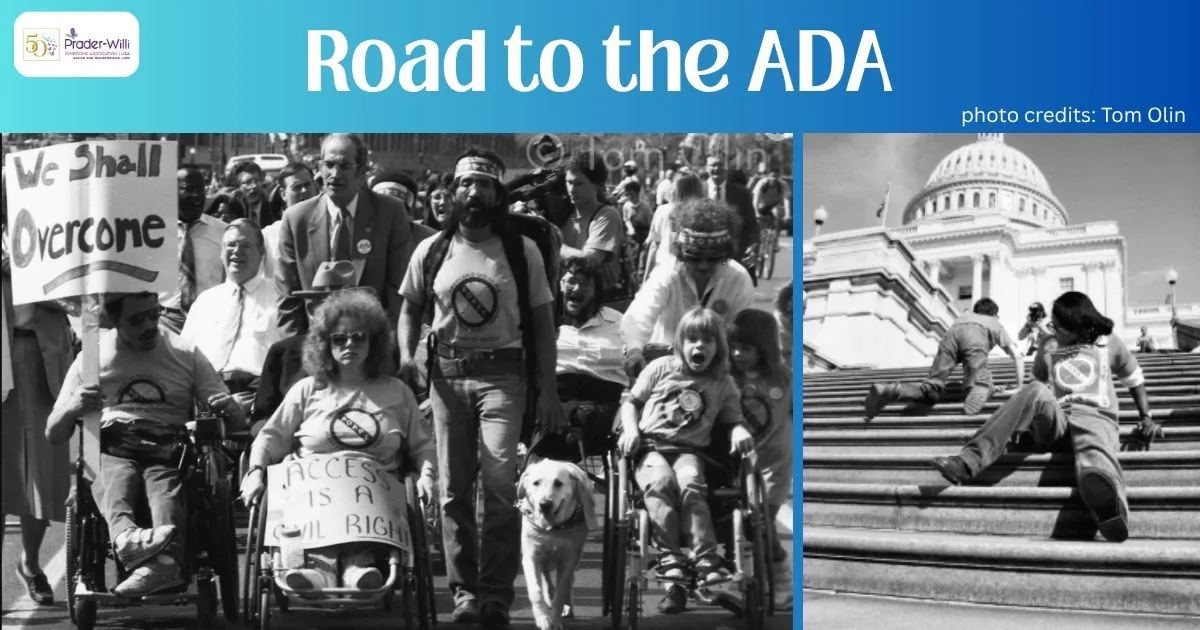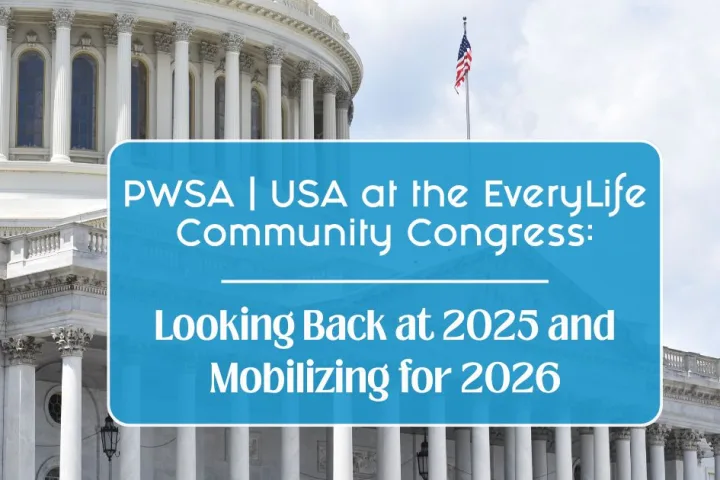On Saturday, July 26, 2025, the Americans with Disabilities Act will celebrate 35 years! This anniversary celebrates a victory at least a century in the making, upon which advocates must continue to build. The road to this legislative act was long, but there were dedicated advocates who fought along the way to ensure individuals with disabilities would be free from discrimination, at least legally, in various public aspects of our society. Our loved ones today know rights and recognition beyond the scope many in our society’s past could have realized, and while our fights are not over, we should be truly grateful for the many advocates who got us where we are today.
Our cultural and societal treatment of people with disabilities is a long, dark history. Despite this history, it is important to remember that people have always been standing up and advocating for their disabled neighbors and loved ones. The ADA was a recent, and momentous stop on this journey as what was first officially recognized as a movement in the ’30s, finally became law in 1990.
In 1935, President Franklin. D. Roosevelt’s Work Progress Administration published a “formal but secret” document that labeled disabled people as “unemployables.” The League for the Physically Handicapped, “the first direct-action disability activist group in the United States,” took offense. In 1936, it sent a delegation of 33 men from New York to Washington, D.C., to demand jobs for disabled men. In response to the WPA’s label, H. D. Hicker and M. M. Walter, president and chairman, respectively, of the National Rehabilitation Association wrote:
“It has already come to our attention that discrimination has been shown against the employment of the disabled in these activities, on the basis that they are unemployable. Fourteen years of experience in rehabilitating the disabled, during which time over 70,000 persons have been rehabilitated, proves that workers, though partially disabled, are not unemployable.” League of the Physically Handicapped (U.S. National Park Service)
(It is important to note here that the disability advocacy of this time seemed to focus heavily on war veterans who suffered permanent injuries during military service or those who acquired their disability through illnesses like polio, and not the larger disability community that we know today. But it does seem an important stop along the journey of fighting against job discrimination for those with disabilities.)
In 1940, the first national disability non-profit to lobby against job discrimination was founded (chartered in 1942), The American Federation for the Physically Handicapped. This organization was based out of Washington, D.C., and had handicapped and non-handicapped members. “At the beginning of World War II the nation was in need of manpower and America had millions of men and women willing to do their share even though they could not meet the physical requirements for service in the armed forces. It was then the American Federation of the Physically Handicapped began its crusade to convince the employer that qualified physically handicapped men and women could, through selective placement, do a good job.” The Work of the American Federation of the Physically Handicapped.
The ADA largely found its roots in the 1973 Rehabilitation Act. While this act was drafted in 1973, it was not until 1977 that a key anti-discrimination element, Section 504, was published. We have activists like Judy Huemann to thank for that.
Judy contracted polio as a young girl and was subsequently paralyzed. She came to be known as the “Mother of the Disability Rights Movement.” In 1977, she was an organizer and leader of a national protest in both San Francisco and Washington, D.C. California activists, along with Judy, launched a protest at a local branch of the federal Health Education and Welfare Office in San Francisco. After 20 days, Section 504 of the Rehabilitation Act of 1973 was signed.
“The goal of section 504 was to prohibit discrimination based on disability and ensure accessibility of public buildings and programs. This would allow disabled people to have access to education and employment that they did not have guaranteed at that time. Section 504 had been drafted for some time, but the regulations were not published.” Judy Heumann (U.S. National Park Service)
March 12, 1990, saw another important action that led to the signing of the ADA. On that day, more than 1,000 people marched from the White House to the steps of the Capitol Building. Once there, nearly 60 people, all requiring mobility aids like wheelchairs and walkers, created a historic and moving moment. These individuals set aside their mobility aids and began to climb and crawl up the Capitol steps in what is known as the Capital Crawl.
On July 26, 1990, President George H. W. Bush signed the Americans with Disabilities Act. This act has been monumental in protecting individuals with disabilities from anti-discrimination legislation and ensuring the legal rights of individuals with disabilities to live, work, and receive services in our society.
Disability advocates have made incredible strides, especially in the last few decades, and we owe them a debt of gratitude. Our work is not done, however. As we stand on the foundation of anti-discrimination legislation built by the activists before us, it is now our time to continue their work of creating and nurturing a society where our loved ones not only have legal rights against discrimination, but where they are truly embraced as equal and deserving members of society.
Titles of the ADA
Introduction to the Americans with Disabilities Act | ADA.gov
Title I: Employers must provide people with disabilities an equal opportunity to benefit from the employment-related opportunities available to others.
Title II: State and local governments must provide people with disabilities an equal opportunity to benefit from all of their programs, services, and activities. Public transit systems must provide people with disabilities an equal opportunity to benefit from their services.
Title III: Businesses must provide people with disabilities an equal opportunity to access the goods or services that they offer.
Title IV: Requires telephone and Internet companies to provide a nationwide system of interstate and intrastate telecommunications relay services that allows individuals with hearing or speech disabilities to communicate over the telephone.
Title V: Prohibits retaliation against a person who has asserted their rights under the ADA and directs certain federal agencies to issue guidance explaining the law
Share this!





 Perry A. Zirkel has written more than 1,500 publications on various aspects of school law, with an emphasis on legal issues in special education. He writes a regular column for NAESP’s Principal magazine and NASP’s Communiqué newsletter, and he did so previously for Phi Delta Kappan and Teaching Exceptional Children.
Perry A. Zirkel has written more than 1,500 publications on various aspects of school law, with an emphasis on legal issues in special education. He writes a regular column for NAESP’s Principal magazine and NASP’s Communiqué newsletter, and he did so previously for Phi Delta Kappan and Teaching Exceptional Children. Jennifer Bolander has been serving as a Special Education Specialist for PWSA (USA) since October of 2015. She is a graduate of John Carroll University and lives in Ohio with her husband Brad and daughters Kate (17), and Sophia (13) who was born with PWS.
Jennifer Bolander has been serving as a Special Education Specialist for PWSA (USA) since October of 2015. She is a graduate of John Carroll University and lives in Ohio with her husband Brad and daughters Kate (17), and Sophia (13) who was born with PWS. Dr. Amy McTighe is the PWS Program Manager and Inpatient Teacher at the Center for Prader-Willi Syndrome at the Children’s Institute of Pittsburgh. She graduated from Duquesne University receiving her Bachelor’s and Master’s degree in Education with a focus on elementary education, special education, and language arts.
Dr. Amy McTighe is the PWS Program Manager and Inpatient Teacher at the Center for Prader-Willi Syndrome at the Children’s Institute of Pittsburgh. She graduated from Duquesne University receiving her Bachelor’s and Master’s degree in Education with a focus on elementary education, special education, and language arts. Evan has worked with the Prader-Willi Syndrome Association (USA) since 2007 primarily as a Crisis Intervention and Family Support Counselor. Evans works with parents and schools to foster strong collaborative relationships and appropriate educational environments for students with PWS.
Evan has worked with the Prader-Willi Syndrome Association (USA) since 2007 primarily as a Crisis Intervention and Family Support Counselor. Evans works with parents and schools to foster strong collaborative relationships and appropriate educational environments for students with PWS. Staci Zimmerman works for Prader-Willi Syndrome Association of Colorado as an Individualized Education Program (IEP) consultant. Staci collaborates with the PWS multi-disciplinary clinic at the Children’s Hospital in Denver supporting families and school districts around the United States with their child’s Individual Educational Plan.
Staci Zimmerman works for Prader-Willi Syndrome Association of Colorado as an Individualized Education Program (IEP) consultant. Staci collaborates with the PWS multi-disciplinary clinic at the Children’s Hospital in Denver supporting families and school districts around the United States with their child’s Individual Educational Plan. Founded in 2001, SDLC is a non-profit legal services organization dedicated to protecting and advancing the legal rights of people with disabilities throughout the South. It partners with the Southern Poverty Law Center, Protection and Advocacy (P&A) programs, Legal Services Corporations (LSC) and disability organizations on major, systemic disability rights issues involving the Individuals with Disabilities Education Act (IDEA), Americans with Disabilities Act (ADA), and the federal Medicaid Act. Recently in November 2014, Jim retired.
Founded in 2001, SDLC is a non-profit legal services organization dedicated to protecting and advancing the legal rights of people with disabilities throughout the South. It partners with the Southern Poverty Law Center, Protection and Advocacy (P&A) programs, Legal Services Corporations (LSC) and disability organizations on major, systemic disability rights issues involving the Individuals with Disabilities Education Act (IDEA), Americans with Disabilities Act (ADA), and the federal Medicaid Act. Recently in November 2014, Jim retired.